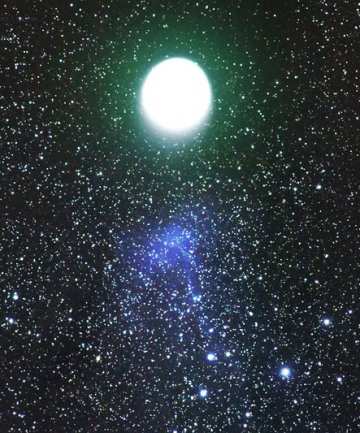 Where's Saturn? Is that a UFO--or the ISS? What's the name of that star? Get the answers from mySKY--a fun new astronomy helper from Meade. Where's Saturn? Is that a UFO--or the ISS? What's the name of that star? Get the answers from mySKY--a fun new astronomy helper from Meade. TAURID METEORS: The annual Nouthern Taurid meteor shower caused by Comet Encke is underway. Although Taurid rates are normally low, only about five meteors per hour, those five can be doozies. The shower is a well-known producer of terrestrial fireballs and lunar explosions. Taurids can appear at any hour of the night, so be alert for meteors this weekend: sky map. SEVERED TAIL: Comet 17P/Holmes is experiencing a "disconnection event"--the comet's beautiful blue ion tail has become disconnected from its head. "The event was easy to photograph last night," says Thorsten Boeckel who send this picture from a dark-sky site 1700m high in the Italian Alps: 
Other astronomers have seen it, too. The disruption does not necessarily signal a new outburst of Comet Holmes. Comet tails can be disconnected by gusts of solar wind which trigger magnetic storms around the comet akin to geomagnetic storms which fuel auroras on Earth. Such a storm and disconnection was observed earlier this year in the tail of Comet Encke: full story. Got a telescope? Monitoring is encouraged: sky map, ephemeris. DOES COMET HOLMES HAVE A SATELLITE? Comet Holmes has erupted twice before, in Nov. 1892 and Jan. 1893. In 1984, great astronomer Fred Whipple proposed an explanation: "An analysis of observations of comet P/Holmes 1892III's two 8-10 mag bursts indicates that these phenomena are consistent with the grazing encounter of a small satellite with the nucleus on November 4.6, 1892, and the final encounter on January 16.3, 1893. While after the first burst the total magnitude fell less than 2 mag from November 7 to 30, the fading was much more rapid after the second burst. It is suggested that the grazing encounter distributed a volume of large chunks in the neighborhood of the nucleus, maintaining activity for weeks." Source: Icarus (ISSN 0019-1035), vol. 60, Dec. 1984, p. 522-531. Whipple's idea might be updated circa 2007 to include a swarm of orbiting debris produced by, say, a previous collision. From time to time a debris-fragment might hit the comet's nucleus causing a new outburst. It's possible: Asteroids have satellites, so why not comets? Furthermore, fragments going around a comet's irregular nucleus would have unstable orbits; from time to time they would naturally crash into the comet or fly off into space. Warning: This is all pure speculation! No one knows why Comet Holmes keeps exploding. Perhaps the modern array of telescopes trained on Comet Holmes in 2007 will solve the mystery--but not yet. For now, we can only watch and wonder: sky map. 3D BONUS: Grab your 3D glasses. Graphic artist Patrick Vantuyne has combined two photos of Comet Holmes, one taken by Jack Newton in Arizona and one by Ivan Eder in Hungary, to create an eye-popping stereo portrait: stereo image. "The stereo effect has nothing to do with the different locations of the photographers," he notes. "It is a result of the movement of the comet among between the two pictures." Comet 17P/Holmes Photo Gallery
[Interactive World Map of Comet Photos]
[sky map] [ephemeris] [3D orbit] [Night Sky Cameras]
| 
